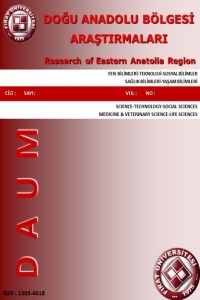YAPILANDIRMACI EĞİTİM VE ÖĞRETİM YAKLAŞIMLARI
Yapılandırmacılık,
epistemolojik bir yaklaşımdır. Bununla beraber eğitim programlarına etki
etmekte ve sı-nıfta eğitim-öğretim uygulamalarını yönlendirmektedir.
Yapılandırmacılık eğitim alanında yeni ortaya çıkan bir kavram olmakla beraber
köken itibariyle çok eskilere dayanmaktadır. Temel yaklaşımı ise bilginin ne
olduğu ve bilenin bunu nasıl bildiği ile ilgilidir. Bilginin ne olduğu ve bunu
insanın nasıl bildiğine ilişkin açıklamaları dolaylı olarak bunun nasıl
öğretileceğine ilişkin de belli bazı ilkeler sunmaktadır. Bu ilkelere dayanan
farklı öğretim uygulamaları önerilmektedir.
Anahtar Kelimeler:
Yapılandırmacılık, Yapılandırmacı Eğitim
___
- 1. Airasian, P. W. & Walsh, M. E. (1997) “Cons-tructivist Cautions (Theory of Constructivism).” Phi Delta Kapan, 78(6), 444-449. ERIC No: EJ 539 113.
- 2. Applefield, J. M., Huber, R. L. & Moallem, M. (2000). Constructivism in Theory and Practice: Toward a Better Undestanding. High School Journal, 84(2), 35-53.
- 3. Ataizi, M. (2001). Durumlu Öğrenme. (Editör: A. Şimşek), Sınıfta Demokrasi. Ankara: Eği-tim Sen Yay. 146-170.
- 4. Ayersman, D. J. (1996). Reviewing the Rese-arch on Hypermedia-Based Learning. Journal of Research on Computing in Education, 28(4), 500-525.
- 5. Becker, D&Dwyer, M. (1994). Using Hyperme-dia to Provide Learner Control. Journal of Multimedia and Hypermedia, 3(2), 155-172.
- 6. Brown, J. S.; Collins, A.&Duguid P. (1989). Situated Cognition and the Culture of Learning. Educational Researcher, 18(1), 32-42.
- 7. Cash, J. R., Behrmann, M. B., Stadt, R. W.&Mc Daniels, H. (1997). Effectiveness of Cognitive Apprenticeship Instructional Methods in Colle-ge Automotive Technology Classrooms. Jour-nal of Industrial Teacher Education, 34(2), 29-49.
- 8. Chen, W.&Rovegno, I. (2000). Examination of Expert and Novice Teachers’ Constructivist-Oriented Teaching Practices Using a Move-ment Approach to Elementary Physical Edu-cation. Elementary Physical Education,7(4), 357-3-368.
- 9. Cobb, P (1994). Where is the Mind? Cons-tructivist and Sociocultural Perspectives on Mathematical Development. Educational Re-searcher, (23), 713-20.
- 10. TGV (1993). Anchored Instruction and Situated Cognition Rewisted. Educational Technology, 33(3), 52-70.
- 11. CTGV (1991). Technology and the Design of Generative Learning Environments. Educatio-nal Technology, May, 34-40.
- 12. Entwisle N. J.& Ramsden, P.(1983). Unders-tanding Student Learning Learning. London: Crook Helm.
- 13. Gagne, E., Yekovich C. W.&Yekovich, F. (1993). The Cognitive Psychology of School-ing Learning. New York: Harper Collins.
- 14. Garrison, J. (1998). Toward a Pragmatic Social Constructivism. (Ed. M. Larochelle, N. Bednarz &J. Garrison). Constructivism and Education. Cambridge, New York: Cambridge Universty Press. 43-60.
- 15. Jarviven, E-M (1999). The Lego Learning En-vironment in Technology Education: An Experiment in a Finnish Context. Journal of Industrial Teacher Education, 37(4), 76-85.
- 16. Jonassen, D. H. (1993). Cognitive Flexibilty Theory and its Implications For Desining CBI (Eds. S. Dijkstra, H. P. Krammer,&J. J. van Merrienboer), Instructional Models in Computer Based Learning Environments. Heidelberg, FRG: Springer-Verlag. 385-404.
- 17. Jonassen, D. H., Dyer, D., Peters, K., Robinson, T., Harvey, D., King, M. & Loughner, P. (1997). Cognitive Flexibility Hypertexts on the Web: Engaging Learners in Meaning Making. (Ed. B. Khan ), Web-based instruction. Englewood Cliffs, NJ: Educational Technology Publications. 119-134.
- 18. McLellan, H. (1996) Being digital; Implications for Education. Educational Technology, No-vember/December, 5-20.
- 19. Piaget, J. (1976). The Child and Reality: Problems of Genetic Psychology. (Translated by Arnold Rasin), Middlesex, England, Penguin Books.
- 20. Prawat, R. S. (1992). Teachers’ Beliefs About Teaching and Learning: A Constructivist Pers-pective. American Journal of Education, 100, 354-395.
- 21. Riordan-Karlsson, M. (2000). Constructivism. Westminster: Teacher Created Materials, Inc.
- 22. Samaras, A. & Gismondi S. (1998). Scaffolds in the Field: Vygotskian Interpretation in a Teacher Education Program. Teaching and Teacher Education, 14(7), 715-733.
- 23. Savery, J. R. & Duffy, T. M. (1995). Problem Based Learning: An Instructional Model and its Constructivist Framework. Educational Tech-nology, 35 (1), 31-38.
- 24. Solomon, J. (2000). The Changing Perspectives of Constructivism: Sicience Wars and Children’ s Creativity. (Ed. D. C. Phillips), Construc-tivism in Education: Opinions and Second Opinions on Controversial Issues. Chicago, Illinois: The University of Chicago Press. 283-307.
- 25. Spiro, R. J., Feltovich, P. J., Jacobson, M. J. & Coulson, R. L. (1995). Cognitive Flexibility, Constructivism and Hypertext: Random Access Instruction for Advanced Knowledge Acquisiti-on in Ill-Structured Domains. (Eds. L. P. Steffe & J. Gale), Constructivism in Education, Hillsdale, NJ: Lawrence Erlbaum Associates, 85-107.
- 26. Von Glasersfeld, E. (1991). Knowing without Metaphysics: Aspects of the Radical Construc-tivist Position. (Ed. F. Steier). Research and Reflexivity. London: Sage Pub. 553-571.
- 27. Vygotsky, Lev S. (1998). Düşünce ve Dil. (Çe-viren; S. Koray). İstanbul: Toplumsal Dönüşüm Yayınları. (1. baskı, 1985), Kaynak Yayınları.
- 28. Applefield, J. M., Huber, R. L. & Moallem, M. (2000). Constructivism in Theory and Practice: Toward a Better Undestanding. High School Journal, 84(2), 35-53.
- 29. Cash, J. R., Behrmann, M. B., Stadt, R. W.& McDaniels, H. (1997). Effectiveness of Cogni-tive Apprenticeship Instructional Methods in College Automotive Technology Classrooms. Journal of Industrial Teacher Education, 34(2), 29-49.
- ISSN: 1303-4618
- Başlangıç: 2002
- Yayıncı: Fırat Üniversitesi
Sayıdaki Diğer Makaleler
KARAR AĞACI YÖNTEMİNİ KULLANARAK TİROİD HORMON PARAMETRELERİNDEN HİPERTİROİDİ VE HİPOTİROİDİ TEŞHİSİ
Şengül DOĞAN, İbrahim TÜRKOĞLU
MİNERAL KATKI KULLANIMININ KARBON FİBER TAKVİYELİ HAFİF BETONDAKİ ETKİLERİ
BLUEBIRD İLKÖĞRETİM OKULUNDA OKUL GELİŞTİRME ÇALIŞMASI
HARPUT (ELAZIĞ) VE ÇEVRESİNİN ETNOBOTANİK ÖZELLİKLERİ
Uğur ÇAKILCIOĞLU, İsmail TÜRKOĞLU, Murat KÜRŞAT
YENİ İLKÖĞRETİM PROGRAMLARININ DAYANDIĞI TEMEL İLKE VE YAKLAŞIMLAR
Mehmet Nuri GÖMLEKSİZ, Ayşe Ülkü KAN
FUARCILIK VE TÜRKİYE’DE FUARCILIKLA İLGİLİ FAALİYETLER
BİR BUZAĞIDA KONGENİTAL TRİGEMİNAL FELÇ
Enis KARABULUT, Mehmet Cengiz HAN
KUANTUM ÖĞRENME MODELİNİN ORTAÖĞRETİM ÖĞRENCİLERİ ÜZERİNDEKİ ETKİSİ
